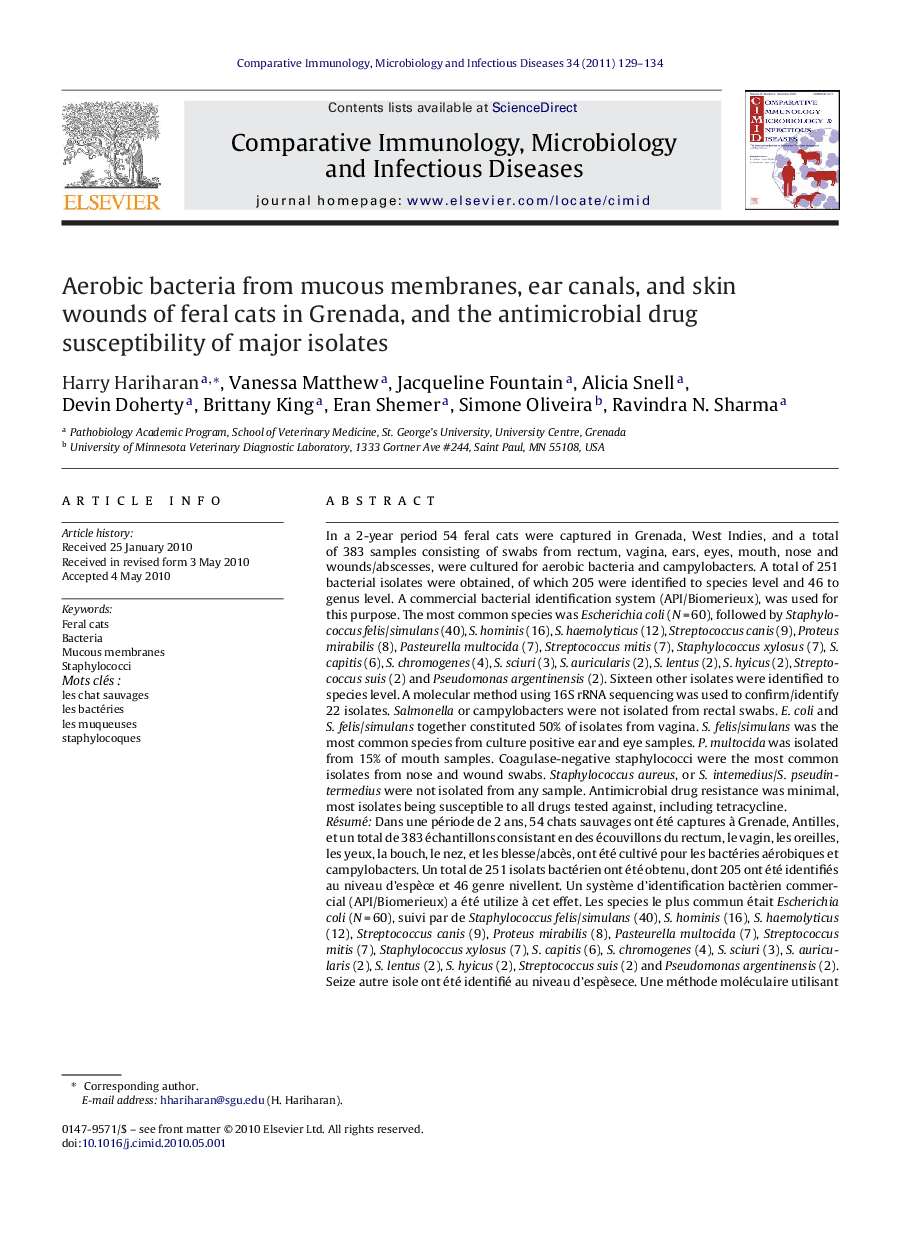| Article ID | Journal | Published Year | Pages | File Type |
|---|---|---|---|---|
| 2428463 | Comparative Immunology, Microbiology and Infectious Diseases | 2011 | 6 Pages |
In a 2-year period 54 feral cats were captured in Grenada, West Indies, and a total of 383 samples consisting of swabs from rectum, vagina, ears, eyes, mouth, nose and wounds/abscesses, were cultured for aerobic bacteria and campylobacters. A total of 251 bacterial isolates were obtained, of which 205 were identified to species level and 46 to genus level. A commercial bacterial identification system (API/Biomerieux), was used for this purpose. The most common species was Escherichia coli (N = 60), followed by Staphylococcus felis/simulans (40), S. hominis (16), S. haemolyticus (12), Streptococcus canis (9), Proteus mirabilis (8), Pasteurella multocida (7), Streptococcus mitis (7), Staphylococcus xylosus (7), S. capitis (6), S. chromogenes (4), S. sciuri (3), S. auricularis (2), S. lentus (2), S. hyicus (2), Streptococcus suis (2) and Pseudomonas argentinensis (2). Sixteen other isolates were identified to species level. A molecular method using 16S rRNA sequencing was used to confirm/identify 22 isolates. Salmonella or campylobacters were not isolated from rectal swabs. E. coli and S. felis/simulans together constituted 50% of isolates from vagina. S. felis/simulans was the most common species from culture positive ear and eye samples. P. multocida was isolated from 15% of mouth samples. Coagulase-negative staphylococci were the most common isolates from nose and wound swabs. Staphylococcus aureus, or S. intemedius/S. pseudintermedius were not isolated from any sample. Antimicrobial drug resistance was minimal, most isolates being susceptible to all drugs tested against, including tetracycline.
RésuméDans une période de 2 ans, 54 chats sauvages ont été captures à Grenade, Antilles, et un total de 383 échantillons consistant en des écouvillons du rectum, le vagin, les oreilles, les yeux, la bouch, le nez, et les blesse/abcès, ont été cultivé pour les bactéries aérobiques et campylobacters. Un total de 251 isolats bactérien ont été obtenu, dont 205 ont été identifiés au niveau d’espèce et 46 genre nivellent. Un système d’identification bactèrien commercial (API/Biomerieux) a été utilize à cet effet. Les species le plus commun était Escherichia coli (N = 60), suivi par de Staphylococcus felis/simulans (40), S. hominis (16), S. haemolyticus (12), Streptococcus canis (9), Proteus mirabilis (8), Pasteurella multocida (7), Streptococcus mitis (7), Staphylococcus xylosus (7), S. capitis (6), S. chromogenes (4), S. sciuri (3), S. auricularis (2), S. lentus (2), S. hyicus (2), Streptococcus suis (2) and Pseudomonas argentinensis (2). Seize autre isole ont été identifié au niveau d’espèsece. Une méthode moléculaire utilisant 16S séquençage de rRNA a été utilisé pour confirmer/identifie 22 isolent. La salmonelle ou campylobacters n’ont pas été isolés des écouvillons rectaux. E. coli et S. felis/simulans ont constitué ensemble 50% d’ isolats du vagin. S. felis/simulans était l’espèce la plus commune de la culture positive échantllons d’oreille et les d’oeil. P. multocida a été isolé de 15% d’échantillons de bouche. Les staphylocoques de coagulase-négatif étaient le plus commun isolats des écouvillons de nez et des blessures. Staphylococcus aureus, ou S. intermedius/pseudintermedius n’a pas été isolé de l’échantillon. La résistance antimicrobienne de antibiotique était minimale, la plupart d’ isolats être susceptible à tous antibiotiques essayés contre, y compris tetracycline.
